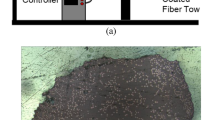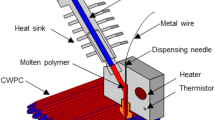Abstract
Fused deposition modeling (FDM) has been used to manufacture complicated structures and robots in the past few years. However, most FDM machines do not fabricate fully functional robots that are ready for use. One of the requirements of fully functional 3D printed robots is electrical connection in some part of the printed structure. Recently, electrically conductive commercial filaments are emerging to the market, but the actual chemical compositions of the filler and host materials as well as mechanical properties are not available. This paper presents composite materials consisting of conductive carbon nanoparticles, thermoplastics, and solvents to create thin filaments for 3D printing. The mechanical and electrical properties of the filaments fabricated using a composition of 0–15% weight of carbon nanoparticles (NC) in polylactide (PLA) and dichloromethane (DCM) solvent were investigated. The DCM is used for dissolving the PLA and dispersion of the NC, which is subsequently evaporated by drying. The electrical conductivity of the composite filament is compared with commercial and academia counterparts. Possible applications of the composite materials for fabrication of electrical circuitry for 3D printed robots were also discussed.















Similar content being viewed by others
References
Bak D (2003) Rapid prototyping or rapid production? 3D printing processes move the industry towards the latter. Assemb Autom 23(4):340–345
Wu L, Larkin M, Potnuru A, Tadesse Y (2016) HBS-1: a modular child-size 3D printed humanoid. Robotics 5(1):1
Potnuru A, Jafarzadeh M, Tadesse Y (2016) 3D printed dancing humanoid robot “Buddy” for homecare. In: 2016 IEEE international conference on automation science and engineering (CASE). IEEE, pp 733–738
Arjun A, Saharan L, Tadesse Y (2016) Design of a 3D printed hand prosthesis actuated by nylon 6–6 polymer based artificial muscles. In: 2016 IEEE international conference on automation science and engineering (CASE). IEEE, pp 910–915
Saharan L, Tadesse Y (2016) Robotic hand with locking mechanism using TCP muscles for applications in prosthetic hand and humanoids. SPIE smart structures and materials + nondestructive evaluation and health monitoring, 2016. International Society for Optics and Photonics, 97970V–97979
Saharan L, Sharma A, de Andrade MJ, Baughman RH, Tadesse Y (2017) Design of a 3D printed lightweight orthotic device based on twisted and coiled polymer muscle: iGrab hand orthosis. SPIE smart structures and materials + nondestructive evaluation and health monitoring. International Society for Optics and Photonics, pp 1016428–1016410
Tadesse Y, Wu L, Saharan LK (2016) Musculoskeletal system for bio-inspired robotic systems. Mech Eng 138(3):S11
Ladd C, So JH, Muth J, Dickey MD (2013) 3D printing of free standing liquid metal microstructures. Adv Mater 25(36):5081–5085
Khaing M, Fuh J, Lu L (2001) Direct metal laser sintering for rapid tooling: processing and characterisation of EOS parts. J Mater Process Technol 113(1):269–272
Rosochowski A, Matuszak A (2000) Rapid tooling: the state of the art. J Mater Process Technol 106(1):191–198
Park BK, Kim D, Jeong S, Moon J, Kim JS (2007) Direct writing of copper conductive patterns by ink-jet printing. Thin Solid Films 515(19):7706–7711
Van Osch TH, Perelaer J, de Laat AW, Schubert US (2008) Inkjet printing of narrow conductive tracks on untreated polymeric substrates. Adv Mater 20(2):343–345
Kamyshny A, Steinke J, Magdassi S (2011) Metal-based inkjet inks for printed electronics. Open Appl Phys J 4:19–36
Bikas H, Stavropoulos P, Chryssolouris G (2016) Additive manufacturing methods and modelling approaches: a critical review. Int J Adv Manuf Technol 83(1–4):389–405
Irfan M (2012) Chemistry and technology of thermosetting polymers in construction applications. Springer, Dordrecht
Walters P, Huson D, Parraman C, Stanić M (2009) 3D printing in colour: technical evaluation and creative applications. In: Impact 6 international printmaking conference
Rengier F, Mehndiratta A, von Tengg-Kobligk H, Zechmann CM, Unterhinninghofen R, Kauczor H-U, Giesel FL (2010) 3D printing based on imaging data: review of medical applications. Int J Comput Assist Radiol Surg 5(4):335–341
Krzyzanowski M, Svyetlichnyy D, Stevenson G, Rainforth WM (2016) Powder bed generation in integrated modelling of additive layer manufacturing of orthopaedic implants. Int J Adv Manuf Technol 87:519–530
Horvath J (2014) A brief history of 3D printing Mastering 3D printing. Springer, Berlin, pp 3–10
Hwang S, Reyes EI, Moon K-S, Rumpf RC, Kim NS (2015) Thermo-mechanical characterization of metal/polymer composite filaments and printing parameter study for fused deposition modeling in the 3D printing process. J Electron Mater 44(3):771–777
Love LJ, Kunc V, Rios O, Duty CE, Elliott AM, Post BK, Smith RJ, Blue CA (2014) The importance of carbon fiber to polymer additive manufacturing. J Mater Res 29(17):1893–1898
Sa’ude N, Ibrahim M, Ibrahim MHI (2013) Mechanical properties of highly filled iron-ABS composites in injection molding for FDM wire filament. In: Materials Science Forum, 2013. Trans Tech Publications, Zurich, pp 448–453
Tsiakatouras G, Tsellou E, Stergiou C (2014) Comparative study on nanotubes reinforced with carbon filaments for the 3D printing of mechanical parts. Trans Eng Technol Edu 12(3):392–396
Zhang D, Chi B, Li B, Gao Z, Du Y, Guo J, Wei J (2016) Fabrication of highly conductive graphene flexible circuits by 3D printing. Synth Met 217:79–86
Nicholson JC (2015) Nanoenhanced additive manufacturing: additive introduction onto halloysite nanotubes and into 3D printing filament for tailored material characteristics. Louisiana Tech University, Ruston
Wei X, Li D, Jiang W, Gu Z, Wang X, Zhang Z, Sun Z (2015) 3D printable graphene composite. Sci Rep 5:1118
Graphene 3D Lab Inc. (2016) Conductive graphene filament. http://www.graphene3dlab.com/s/filament.asp. Accessed 30 Sept 2016
Leigh SJ, Bradley RJ, Purssell CP, Billson DR, Hutchins DA (2012) A simple, low-cost conductive composite material for 3D printing of electronic sensors. PLoS ONE 7(11):e49365
Devaux E, Aubry C, Campagne C, Rochery M (2011) PLA/carbon nanotubes multifilament yarns for relative humidity textile sensor. J Eng Fiber Fabr 6:13–15
Oliveira JE, Mattoso LHC, Medeiros ES, Zucolotto V (2012) Poly(lactic acid)/carbon nanotube fibers as novel platforms for glucose biosensors. Biosensors 2(1):70–82
Vincent-Hughes IT, Kambiz C, Daniel T (2016) 3D printable conductive nanocomposites of PLA and multi-walled carbon nanotubes. Mater Matters 11:2
Guo S-z, Yang X, Heuzey M-C, Therriault D (2015) 3D printing of a multifunctional nanocomposite helical liquid sensor. Nanoscale 7(15):6451–6456
Novakova-Marcincinova L, Kuric I (2012) Basic and advanced materials for fused deposition modeling rapid prototyping technology. Manuf Ind Eng 11(1):24–27
Proto-pasta Conductive PLA. https://www.proto-pasta.com/pages/conductive-pla. Accessed 20 Aug 2017
Functionalize-Electric™ PLA. http://functionalize.com/about/functionalize-f-electric-highly-conductive-filament/. Accessed 8 Aug 2017
Multi3D. https://www.multi3dllc.com/product/electrifi-3d-printing-filament/. Accessed 20 Aug 2017
3DXNANO™ ESD CNT-PETG carbon nanotube reinforced polyethylene terephthalate glycol copolymer 3D printing filament. http://www.sigmaaldrich.com/catalog/product/aldrich/3dxcnt003?lang=en®ion=US&cm_sp=Insite-_-recent_fixed-_-recent5-2. Accessed 23 Aug 2017
Espalin D, Muse DW, MacDonald E, Wicker RB (2014) 3D printing multifunctionality: structures with electronics. Int J Adv Manuf Technol 72(5–8):963–978
Averous L, Moro L, Dole P, Fringant C (2000) Properties of thermoplastic blends: starch–polycaprolactone. Polymer 41(11):4157–4167
Potnuru A, Tadesse Y (2014) Synthesis and characterization of hybrid actuator based on polypyrrole and SMA. ASME 2014 international mechanical engineering congress and exposition, 2014. American Society of Mechanical Engineers, p V003T003A003
Tadesse Y, Brennan J, Smith C, Long TE, Priya S (2010) Synthesis and characterization of polypyrrole composite actuator for jellyfish unmanned undersea vehicle. In: Proceedings of SPIE, the international Society for Optical Engineering, 2010. Society of Photo-Optical Instrumentation Engineers, Bellingham
Tadesse Y, Grange RW, Priya S (2009) Synthesis and cyclic force characterization of helical polypyrrole actuators for artificial facial muscles. Smart Mater Struct 18(8):085008
Foulger SH (1999) Electrical properties of composites in the vicinity of the percolation threshold. J Appl Polym Sci 72(12):1573–1582
Morgan AJ, San Jose LH, Jamieson WD, Wymant JM, Song B, Stephens P, Barrow DA, Castell OK (2016) Simple and versatile 3D printed microfluidics using fused filament fabrication. PLoS ONE 11(4):e0152023
Belter JT, Dollar AM (2015) Strengthening of 3D printed fused deposition manufactured parts using the fill compositing technique. PLoS ONE 10(4):e0122915
Gao Y, Li H, Liu J (2012) Direct writing of flexible electronics through room temperature liquid metal ink. PLoS ONE 7(9):e45485
Yeo J, Hong S, Lee D, Hotz N, Lee M-T, Grigoropoulos CP, Ko SH (2012) Next generation non-vacuum, maskless, low temperature nanoparticle ink laser digital direct metal patterning for a large area flexible electronics. PLoS ONE 7(8):e42315
Kumar B, Castro M, Feller J-F (2012) Poly(lactic acid)–multi-wall carbon nanotube conductive biopolymer nanocomposite vapour sensors. Sens Actuators B 161(1):621–628
Mukhopadhyay S (2011) Nanoscale multifunctional materials: science & applications. Wiley, New York
Liang C, Li Z, Dai S (2008) Mesoporous carbon materials: synthesis and modification. Angew Chem Int Ed 47(20):3696–3717
Sobkowicz MJ, Dorgan JR, Gneshin KW, Herring AM, McKinnon JT (2009) Supramolecular bioNanocomposites: grafting of biobased polylactide to carbon nanoparticle surfaces. Aust J Chem 62(8):865–870
Srivastava S (2012) Effect of aggregation on thermal conductivity and viscosity of nanofluids. Appl Nanosci 2(3):325–331
Meister S (2012) grain and particle analysis with line intersection method—File Exchange—MATLAB Central. http://www.mathworks.com/matlabcentral/fileexchange/35203-grain-and-particle-analysis-with-line-intersection-method. Accessed 9–26 2014
Sathyanarayana S, Hübner C (2013) Thermoplastic nanocomposites with carbon nanotubes. In: Njuguna IJ (ed) Structural nanocomposites. Springer, Berlin, pp 19–60
Liu R, Ma G, Meng F-T, Su Z-G (2005) Preparation of uniform-sized PLA microcapsules by combining Shirasu Porous Glass membrane emulsification technique and multiple emulsion-solvent evaporation method. J Controll Release 103(1):31–43
Haroosh HJ, Chaudhary DS, Dong Y (2012) Electrospun PLA/PCL fibers with tubular nanoclay: morphological and structural analysis. J Appl Polym Sci 124(5):3930–3939
Jakus AE, Secor EB, Rutz AL, Jordan SW, Hersam MC, Shah RN (2015) Three-dimensional printing of high-content graphene scaffolds for electronic and biomedical applications. ACS Nano 9(4):4636–4648
Potnuru A (2013) Low noise, interactive robotic system for psychiatric rehabilitation of children. The University of Texas at Dallas, Richardson
Burns A, Tadesse Y The mechanical design of a humanoid robot with flexible skin sensor for use in psychiatric therapy. SPIE smart structures and materials + nondestructive evaluation and health monitoring, 2014. International Society for Optics and Photonics, pp 90562H–90511
Acknowledgements
Part of this work is supported by the Office of Naval Research (ONR), Young Investigator Program, under the Grant Number N00014-15-1-2503.
Author information
Authors and Affiliations
Corresponding author
Additional information
Publisher’s Note
Springer Nature remains neutral with regard to jurisdictional claims in published maps and institutional affiliations.
Electronic supplementary material
Below is the link to the electronic supplementary material.
Supplementary material 2 (AVI 7587 KB)
Supplementary material 3 (AVI 10120 KB)
Rights and permissions
About this article
Cite this article
Potnuru, A., Tadesse, Y. Investigation of polylactide and carbon nanocomposite filament for 3D printing. Prog Addit Manuf 4, 23–41 (2019). https://doi.org/10.1007/s40964-018-0057-z
Received:
Accepted:
Published:
Issue Date:
DOI: https://doi.org/10.1007/s40964-018-0057-z




